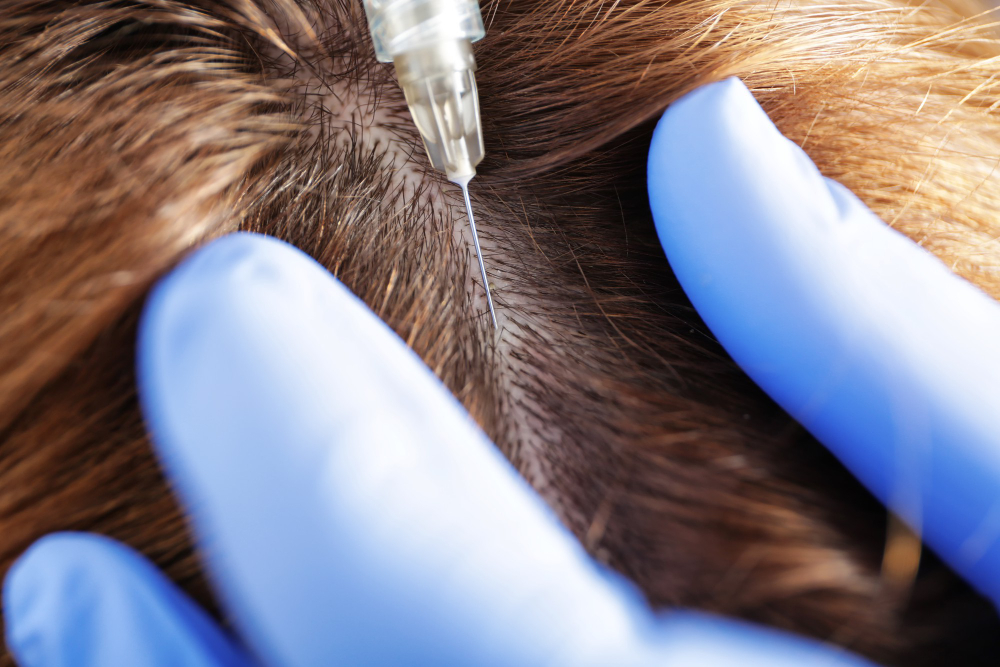
Hair Transplant for Women
Hair transplantation is a successful treatment option that impacts those who suffer from hair loss, affecting all aspects of their lives. While most transplant recipients are males, many women are also starting to look into hair transplants to combat the loss of hair.
Hair transplantation is thought to be a necessary treatment since the outcome of this procedure is likely to affect a woman's appearance. Beyond the negative impact on appearance, losing hair can cause anxiety and depression.
This issue is affecting women more than males. It is also observed that women tend to have serious psychological problems, like feeling inadequate within a social setting and spending a lot of effort and time trying to cover up thinning hair and bald patches, or being unable to accept their hair loss.
This issue is affecting women more than males. It is also observed that women tend to have serious psychological problems, like feeling inadequate within a social setting and spending a lot of effort and time trying to cover up thinning hair and bald patches, or being unable to accept their hair loss.
Women's Pattern Hair Loss, also known as Androgenetic Alopecia, is the most frequent reason for hair loss in women.

Other causes that could be causing hair loss among women are:
Predisposition genetically predisposed to hair loss
Autoimmune illnesses
Change in hormone levels
Medication
Menopause
Pregnancy
Excessive stress
Crash dieting/rapid weight loss
Iron Deficiency
Let's begin our study by looking over the most popular medical hair loss disorder, Androgenetic Alopecia.
Androgenetic Alopecia
The follicular changes that lead to androgenetic alopecia are the same between female and male pattern hair loss. Diminution of the terminal (thick and dark) hair follicles (hair miniaturization) transition to airport (conversion of dark and thick terminal hairs into thin white strands, referred to as Vellus) and a shorter hair growth cycle and, eventually shed. While male or female hair loss has certain features, they are distinct in many aspects.
The loss of hair in men typically manifests as decreasing hairline (frontal area) and affecting the temples (temporal region) as well as the region around the crown (vertex region). However, women tend to lose the hair around their heads. It is uncommon for women to go through total baldness.
In male-pattern baldness, receding causes hairlines to slide backward, resulting in receding hairlines slowly. However, receding hairlines in women is rare, and most women tend to keep their hairline. Women's hair loss is usually characterized by general thinning of the scalp, or in a specific area, the affected areas are limited to particular regions on your scalp. Since it is a common pattern, it's much easier to recognize male-pattern baldness than female-specific hair loss. Additionally, since the loss of hair in women can be caused by numerous ailments, it can be more difficult to identify than men.
Androgenetic Alopecia among women could manifest in three different hair loss types:
Diffuse (progressive)
Localized (stable)
Patterned (male-patterned)
Diffuse (progressive) (progressive): This type of hair loss problem is defined by the thinning and diffuse appearance of the crown region, extending throughout the scalp and retaining the hairline on the front.
Based on the degree of hair loss, The progression of female pattern baldness could be classified according to the Ludwig Scale as Ludwig I II III.
Ludwig I
Type I is the first stage of loss of hair. Hair loss that is thinning over the crown is believed to be mild.
Ludwig II
At this point, the thinness on the crown is increasing. Ludwig II stage is accompanied by a significant diminution in hair density and an increase in the size of the midline of the scalp. If the patient is healthy and has hair follicles within the donor area, then a hair transplant procedure might be an option.
Ludwig III
The frontal hairline remains intact, but the area of the crown now shows significant loss of hair, the portion line has significantly increased, and the hair is so thin that it's impossible to cover the scalp.
When the patient is blessed with sufficient donor reserves, at this point, the only option would be to go through a hair transplant.
Localized (stable) The kind of hair loss is distinguished with the recession in the middle line at the center of the scalp, without the diffuse loss.
Localized (stable) The kind of hair loss is distinguished with the recession in the middle line at the center of the scalp, without the diffuse loss.
The bitemporal recession distinguishes the pattern (Male Patterned) Hair loss that is pattern-based at the temples. This causes the frontal hairline to inwards and then recede (Hamilton).
The hair loss type described here is similar to the pattern seen in male pattern hair loss (forming an M - or V-shaped shape).
Ways to Prevent Hair Loss in Women
Hair loss prevention is achieved through medical treatments, self-care, and a healthy eating regimen. Before recommending any treatment program for women, YOU must determine the hair loss kind and its reasons. You can only accomplish this through the accurate diagnosis provided by a specialist physician. In addition, determining the specifics of the hair loss issue (such as whether it's permanent or temporary and permanent or stable) is also helpful in deciding on an effective therapeutic strategy that is appropriate for your patient.
The main treatment options that are recommended for women are:

Hair Transplantation: Hair transplant, providing a permanent remedy for hair loss. It is the procedure of removing follicular units of the donor site (taking place in the rear of the scalp). This is because the donor area is genetically invulnerable to hair loss and can be transplanted to areas of loss of hair in the hair. This procedure, which is not invasive, yields positive results for women suffering from permanent hair loss issues if they have enough donor supply. Hair transplantation is recognized in the most popular procedures for women suffering from men-like or localized hair loss.
Minoxidil Topical solutions of Minoxidil are the sole androgen-independent medicine that the FDA has accepted. Minoxidil topical application to the scalp increases hair growth, which can help to slow down and slow the growth of hair loss. Women should use minoxidil-based topical treatment.
PRP The PRP treatment is non-surgical and a safe treatment alternative for treating hair loss. PRP involves centrifuging the patient's blood to take those red blood cells and the plasma with a high platelet count and then injecting this platelet-rich plasma into the affected areas.
Hair Mesotherapy
Hair Mesotherapy is the method that involves the application of small amounts of certain medications on the skin using specially designed needles. It is a different treatment that can prevent hair loss and encourage hair growth.
A Healthy and Fit Diet A diet that is high in protein like red meat, fish egg, whole grain and eggs along with biotin magnesium, zinc selenium, vitamins A E C, and B6, which are present in bananas, spinach, and greens, will aid in filling your hair with nutrients. This can improve and safeguard your hair and hair strands.
Statistics on Women's Hair Loss
One in four women experiences hair loss. This amount increases to 2 out of 4 women undergoing menopausal changes.
Around 60% of the women who experience hair loss are genetically inherited "female pattern loss."
There are about 30 diseases that cause female hair loss, but only a handful are the main cause of women.
Over 10% of premenopausal women and around 50percent of females over 65 suffer from thin hair.
In contrast, 84% of women who suffer from hair loss suffer from low self-esteem, %34 suffer from depression, and 94% view their hair loss situation as unacceptable compared to males.
In contrast, 84% of women who suffer from hair loss suffer from low self-esteem, %34 suffer from depression, and 94% view their hair loss situation as unacceptable compared to males.
Around 17.5 percent of hair transplant patients around the globe are females.
Another aspect worth noting is that women who suffer from women's pattern loss of hair need an alternative approach to hair transplantation. Compared to men, loss of hair for women typically does not result in a receding hairline. The most at risk are the vertex (crown regions) and the parietal area. Because of this, any hair transplant procedure carried out on women requires an extremely high level of knowledge.
Hair Transplant for Women
The basic principles remain the same; when it comes to procedures to transplant hair for women, it is crucial to take their particular circumstances to be considered.
The stages of hair transplantation to women can be described follows;
The stages of hair transplantation to women can be described follows;
First place, on the back of the head, a tiny space is created for the harvesting surface, and only this part is cut. Because the existing hair will conceal the shaving area, no one will observe that the patient has gone through the procedure.
When the patient has been administered local anesthetics using needle-free and painful jet injectors follicular unit is then removed using micromotors that use thin hollow needles with an average diameter of 0.6-0.8 millimeters.
Then, the hair follicles will be transplanted one at a time into wounds inside the recipient site, which are made with exact precision, keeping in mind their natural orientation and direction in hair development.
The process of transplantation is carried out using sleek and well-cut Sapphire blades.
Suppose the procedure for hair transplantation involves the placement of the grafts inside the hair strands already present. In that case, The transplantation procedure will be performed using the DHI method by utilizing an implanter (Choi).
Like all hair transplant procedures, the procedure for women's hair transplants should be planned and tailored following your requirements. Therefore when you meet with your consultant and have the right process executed by a trained physician, it's possible to restore the hair you previously lost. Hair Clinic Istanbul, we provide hair transplantation for women.